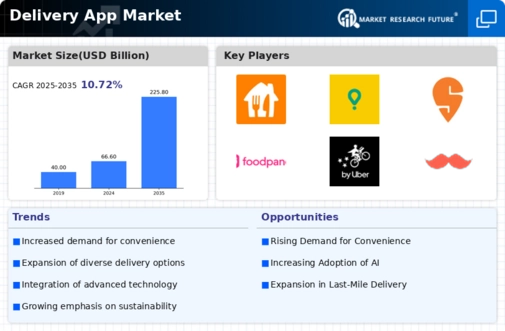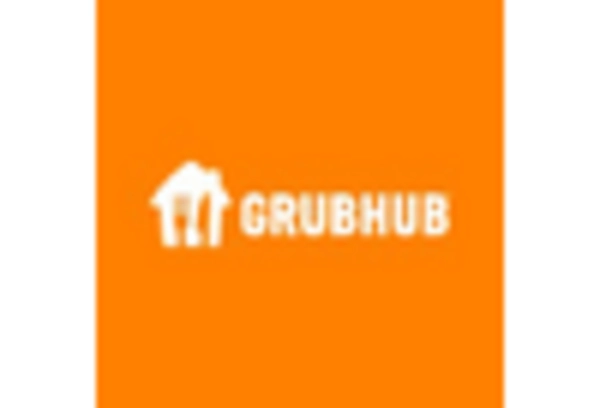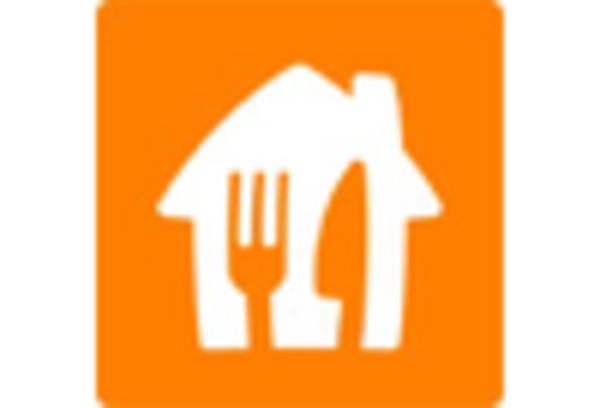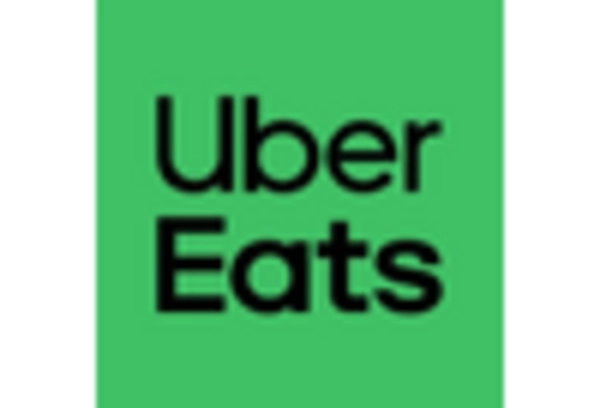The Delivery App Market is currently characterized by a dynamic competitive landscape, driven by rapid technological advancements and evolving consumer preferences. Major players such as Uber Eats (US), DoorDash (US), and Just Eat Takeaway (GB) are at the forefront, each adopting distinct strategies to enhance their market positioning. Uber Eats (US) continues to innovate through its integration of AI-driven logistics, which optimizes delivery routes and reduces wait times, thereby improving customer satisfaction. Meanwhile, DoorDash (US) has focused on regional expansion, recently entering new markets in Southeast Asia, which indicates a strategic move to diversify its operational footprint. Just Eat Takeaway (GB) appears to be concentrating on partnerships with local restaurants, enhancing its offerings and catering to regional tastes, which collectively shapes a competitive environment that is increasingly reliant on localized strategies.
The business tactics employed by these companies reflect a moderately fragmented market structure, where competition is fierce yet varied. Localizing services and optimizing supply chains are pivotal tactics that these companies leverage to gain a competitive edge. The influence of key players is substantial, as they not only set market trends but also dictate pricing strategies and service standards, thereby shaping consumer expectations across the globe.
In August 2025, DoorDash (US) announced a strategic partnership with a leading grocery chain, allowing it to expand its delivery services beyond restaurant food to include grocery items. This move is significant as it positions DoorDash (US) to capture a larger share of the growing online grocery market, which has seen increased demand. By diversifying its service offerings, DoorDash (US) is likely to enhance customer loyalty and increase order frequency, thereby solidifying its market presence.
In September 2025, Uber Eats (US) launched a new subscription service aimed at providing customers with unlimited free deliveries for a monthly fee. This initiative is strategically important as it not only incentivizes repeat usage but also fosters a sense of community among users, potentially increasing customer retention rates. The subscription model may also serve as a buffer against price competition, allowing Uber Eats (US) to differentiate itself through value-added services rather than solely on price.
In October 2025, Just Eat Takeaway (GB) revealed plans to invest in sustainable delivery methods, including electric vehicles and eco-friendly packaging. This strategic pivot towards sustainability is indicative of a broader trend within the industry, as consumers increasingly prioritize environmentally responsible practices. By aligning its operations with sustainability goals, Just Eat Takeaway (GB) is likely to enhance its brand image and appeal to a growing demographic of eco-conscious consumers.
As of October 2025, the competitive trends within the Delivery App Market are increasingly defined by digitalization, sustainability, and the integration of AI technologies. Strategic alliances are becoming more prevalent, as companies seek to enhance their service offerings and operational efficiencies. Looking ahead, competitive differentiation is expected to evolve, with a notable shift from price-based competition towards innovation, technology integration, and supply chain reliability. This transition suggests that companies that prioritize technological advancements and sustainable practices will likely emerge as leaders in the market.

















Leave a Comment